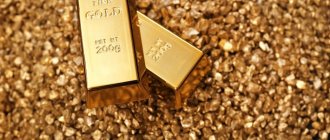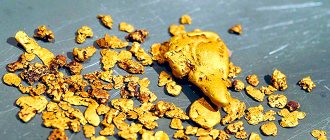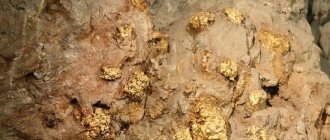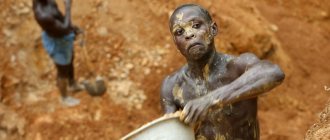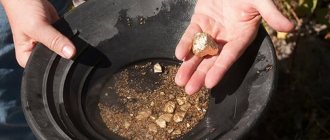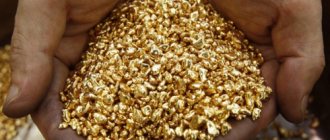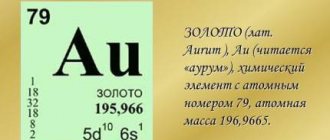Gold deposits of Kazakhstan on Igor Garshin’s website
Home
| Write |
Home > Natural Sciences > Earth Sciences > Geosphere Sciences > Geology of Gold > Gold Mines of the World > Gold in Kazakhstan
Alphabetical list of pages: | | | | | E (Yo) | | | | | | | | | | | | | | | | | | | | | | | | 0-9 | AZ (English)
| The process of origin of gold is still unknown to science. |
The page contains information on metallogenesis and Russian gold mining (with a list of gold mines and mines in Kazakhstan).
Page sections:
- Mineral resource base of the gold mining industry in Kazakhstan
- Main deposits and gold mining companies of the Republic of Kazakhstan
- Gold production in the Republic of Kazakhstan
- Sources
Interesting pages:
- Patterns in the location of gold
- Gold mining companies
- Quadrant grouping of gold mines (by longitudinal-latitudinal cells)
Gold deposits in Kazakhstan are actually gold ore deposits and complex deposits. In the latter, gold occurs predominantly in the form of fine inclusions in sulfide minerals and is recovered along the way. Endogenous gold ore deposits themselves are common in Paleozoic strata. Exogenous deposits (mainly alluvial Quaternary placers) are located in foothill valleys, less often in lowland river valleys. Placer manifestations of Cretaceous-Paleogene age are known. Endogenous deposits are represented by gold-quartz, gold-sulfide, gold-skarn, gold-metasomatic (beresitic, listvenite), gold-quartz-adularia, gold-sulfide-quartz, gold-sulfide-carbon formations.
Gold fineness is 450-900, increases in oxidized ores. Ore bodies - veins, lenses, lens-shaped bodies of complex shape, linear zones, stockworks, etc. The main gold mineralization occurred during the orogenic and post-orogenic stages of regional development. According to the time of formation, gold was recorded in the Precambrian (Ulutau), but the bulk of the deposits were formed in the Caledonian and Hercynian metallogenic eras.
List of gold mines and mines in Kazakhstan:
- Abyz
: 49° 21′ 0″ N 76° 32′ 24″ E - Akbakay
: 44° 39′ 29″ N 74° 11′ 11″ E - Akbastau-
Kosmurun: 48° 45′ 0″ N 77° 40′ 0″ E - Aksu
: 52° 25′ 08″ N, 72° 00′ 00″ E [northern Kazakhstan] - Arharli
: 44° 8′ 13″ N 78° 18′ 45″ E - Bayarchik
: 49° 38′ 48″ N 81° 9′ 0″ E - Bestobe
: 52° 36′ 18″ N, 73° 13′ 48″ E [northern Kazakhstan] - Boko
: 48° 59′ 48″ N 81° 41′ 24″ E - Vasilievskoe
: 53° 29′ 17″ N 69° 32′ 24″ E - from 50 to 55 northern latitudes. and from 60 to 65 east. - Sayak
: 47° 10′ 0″ N 77° 20′ 0″ E - Stepnyak
: 52° 50′ 13″ N, 70° 55′ 12″ E. [northern Kazakhstan] - Suzdal
: 50° 40′ 0″ N 78° 50′ 0″ E - Zholymbet
: 51° 43′ 12″ N, 71° 46′ 12″ E. [northern Kazakhstan] - Yubileiny
(Jubilenoye): 52° 32′ 24″ N 57° 51′ 36″ E - from 50 to 55 northern latitudes. and from 55 to 60 east.
Gold resources of Kazakhstan
Kazakhstan is one of 16 countries with large gold reserves. In 2021, 85 tons of the precious metal were produced. The state buys the entire product, replenishing gold and foreign exchange reserves.
Historical reference
The Golden Man is one of the national symbols of the Republic of Kazakhstan. This is the name given to a collection of ancient precious jewelry discovered in 1969 during archaeological excavations of a mound 50 km from the city of Almaty. More than a thousand plates were sewn onto clothes, hats and shoes. In addition to precious clothing, rings, weapons, and figurines made of pure gold were found in the burial.
This find confirmed the scientists’ version that the first gold miners were the Chud tribes. The proof comes from ancient developments called “splashes.”
Such adits were narrow catacombs in which one could only move by crawling. The gold and copper ores found were smelted in small furnaces. The finished metal was used to make weapons, luxury items, and jewelry in a unique Scythian or “animal” style. Since the 18th century, the remains of ancient mines have shown where to look for sources of minerals.
First major finds
Further development of gold mining began after the annexation of the lands of modern Kazakhstan to the Russian Empire. Due to the absence of large placer deposits, there was no mass interest in Kazakh gold. Research activities were carried out by military and civilian officials. Typically, testimonies from local residents were collected and an expedition was sent to the area of the proposed resource.
In the first half of the 19th century, mineral exploration began in the northern part. Placer deposits were discovered in the Kokchetav-Borovsky region in the 30s. By the end of the 19th century, 110 gold mines were registered in this area. Among them there were 26 main ones, which yielded three pounds of precious metal per year, which is equal to approximately 50 kg. No work was carried out on the rest of the territory.
By the end of the century, the level of resource production at developed mines is falling, replaced by the study of vein sources. In 1908, a gold mining factory began operating at the Stepnyak mine, which for a long time remained the main source of gold. Work was also carried out in the west, where the sites of Kumak and Dzhetygara were discovered.
The main discoveries of vein sources occurred after the revolution in the 30s. During this period, Stalinskoe (1929), Besyube (1931), Burli, Dzhelambet, Taukin (1932), Karaagach (1933) and a number of others were discovered.
During the Soviet period, the Kazakhstan SSR ranked third in the production of precious metal among the other republics of the USSR, receiving 20 tons of gold annually. After the collapse of the union, the gold mining industry fell into decline, production decreased to 10 tons per year.
Expensive mining: what is investing in gold worth?
Most of Kazakhstan's gold deposits cannot boast of a high content of the precious metal. On average, the gold content in them is about 2 grams
precious metal per ton of ore.
The highest concentration - 7.7 grams
of gold per tonne - is at the Bakyrchik deposit, but due to the presence of arsenic and carbon in the rock, local ores are highly refractory and difficult to extract metal from.
All these factors make gold mining in Kazakhstan a very expensive activity. According to the Committee of Geology and Subsoil Use, over the past 10 years, 1.4 trillion tenge
.
Exploration of promising deposits is also not cheap - 95 billion tenge over 10 years .
— To make gold mining more profitable, it is necessary to increase capacity, build processing factories and equip workshops, and these are additional investments. Most of the equipment used in gold mining and processing is piece units made in the USA, Europe, China, and Russia. These are huge bulldozers, excavators, graders, crushers, mills, presses. We do not produce anything like this and will not produce anything like this.
— Another difficulty is associated with the enrichment of ore and the extraction of metal from it. For example, our RG Gold deposit has easy-to-process ores, and it doesn’t take much effort to extract gold from them. At Vasilkovsky or Bakyrchik there are refractory ores with various impurities, and enterprises need to develop special technologies to open the metal.
The state and Kazakh gold mining companies welcome the entry of new international investors into this industry. 128 billion tenge in the development of the Kyzyl project (Bakyrchik deposit) in Eastern Kazakhstan.
.
Geographical location and landscape features
Kazakhstan is included in the list of the ten largest countries on our planet. Its borders stretch from the Caspian Sea in the west to the Altai Mountains in the north and east. The southern regions are bordered by the peaks of the Tien Shan.
The country's topography is varied. In the western part there are lowland plains, in the central, eastern and southern regions plateaus and mountains predominate. The height of the outstanding mountains reaches seven thousand meters above sea level. More than 44% of the land is desert, while the territory has more than eight thousand rivers and 48,000 lakes.
Water resources are unevenly distributed. In mountainous regions, glaciers serve as a source of water.
Geological characteristics
The geological structure of the territory consists of the collision of three plates - the East European Platform in the west, the West Siberian Plate in the north and the Turanian Plate in the southwest. At the junction of the platforms there are folded zones - the Southern Urals, the Kazakhstan fold system, which occupies almost the entire central part, and the Dzhungar-Balkhash system in the east.
In mountainous areas, rocks from the Paleozoic period are observed in many mountainous areas in the form of sandstone and limestone. They are often adjacent to geological intrusions, or ores of igneous origin, which are associated with deposits of gold, copper, iron and other metals.
What about the mines?
There is a limit level below which it becomes almost impossible to mine the precious metal by open-pit mining. If geological exploration confirms the presence of gold ore in deeper layers of the rock, then a mine is drilled in parallel and these reserves are mined using a closed method.
Some gold mining companies in Kazakhstan use similar practices. For example, in the first decades they develop quarries, and then switch to underground work, or vice versa.
What mineral resources are there in Kazakhstan?
The diverse geological structure of the territory of the Republic of Kazakhstan ensures the presence of deposits of a large number of minerals. More than a hundred elements of the periodic table have been discovered in the depths, of which 80 are mined.
The geological structure determines the nature of the resources. Ore minerals have been discovered in mountainous areas, while lowland areas are rich in sedimentary rocks.
Ore
Ore minerals are located in mountainous areas and plateaus and are distributed in almost all areas. Kazakhstan ranks third among the CIS countries after Russia and Ukraine in terms of iron ore reserves. According to geological exploration, its reserves exceed 17 billion tons. The main deposits are located in sulfur areas. Zinc reserves have also been discovered there, and ores containing tin, nickel, titanium, cobalt, and tantalum are at the development stage.
Polymetallic ores have been discovered in the east. More than 40% of gold reserves are found here, platinum and zinc are found here.
In the mountains of the southern Urals, which are called Mudzhary, there are significant reserves of chromium. Manganese ores have also been discovered. Copper production takes place at the Orlovskoye, Nikolaevskoye, Zhezkazganskoye deposits, which have been operating for a long time. The search for new sources in the east is underway.
Nonmetallic
In addition to ore minerals, Kazakhstan is rich in fuel and non-metallic resources. Large reserves of oil, coal and gas have been discovered in the west and central regions. Obtaining them is one of the priority areas for economic development.
Non-metallic minerals, primarily asbestos, are mined in the Zhezkagan and Zhetygarin deposits. Kazakhstan ranks second in the world in terms of phosphorite reserves. The main sources of phosphorus-containing elements are in the south. In the Caspian lowland there are large reserves of salt, the layer of which exceeds two kilometers.
Mountainous areas are rich in semi-precious stones. The largest mineral deposits include:
- Delbegetey, a source of granite with numerous inclusions of precious and semi-precious stones;
- Altyntobe; dioptase;
- Chokpak; malachite;
- Sarykulboldy; chrysoprase;
- Alpys, Taigyn; turquoise;
- Kalmakkyrgan; rhinestone;
- Akshiman, agate.
There are numerous reserves of diamonds that are found throughout the territory. Rich placers of precious stones are found in the Kokshetau region.
What happens to spent quarries and mines?
When a mined-out quarry is abandoned, a large rampart of waste rock is made along its edges to prevent cars or animals from accidentally falling off the cliff.
According to the rules, waste rocks stored in dumps, which can create dust, must be covered with a fertile layer of soil and planted with vegetation.
Some quarries eventually fill with water and turn into reservoirs.
The mines are mothballed after their completion. The entrances to them are usually blown up, the trunks are filled up or cemented.
The mothballing of mines quite often leads to its flooding with groundwater , as the drainage system stops working.
The rocks that contain vein gold are very strong in structure.
Therefore, in the case of gold mining, mines underground remain empty for hundreds of years until they eventually collapse on their own.
Main gold deposits of the Republic of Kazakhstan
Gold-bearing regions include the northern and western regions. Among the country's deposits are:
- 2 unique: Vasilchikovskoe, Bakyrchik;
- 1 large – Akbokai;
- 11 medium.
The main feature of ore resources is the complex nature of the occurrence of minerals. In addition to ore deposits, alluvial gold sources are located in the central part. They have no industrial value, but legislation allows individuals to engage in artisanal mining.
Field map
The largest number of sources of the precious metal are located in the north and east. Here is a diagram of the location of the deposits:
| Developed | Researched | |
| North | Komarovskoye, Varvarinskoye, Vasilkovskoye, Aksu, Bestyube, Zholymbet, Maykain | Uzboy |
| East | Suzdal | Sekisovskoe, Bakyrchik, Kaskabulak, Akzhal |
| South | Akbokay | Dalabay, Altyntas |
The bulk of gold is mined in the northern regions of Kazakhstan, but the eastern and southern regions also have reserves of the precious metal.
By whom and how is it mined?
In 2021, changes were made to the subsoil law. The state allowed foreign companies to invest capital in the development and production of minerals, including precious metals.
This gave impetus to the development of the industry.
Since 2021, the government of Kazakhstan has allowed individuals to engage in artisanal mining of precious metal. The use of special equipment and deep excavations are prohibited. A license for the use of subsoil is issued by the regional akimat, i.e. local government authority.
Gold mining companies
Firms engaged in exploration and production of gold are divided into two groups:
- Companies operating in complex deposits use gold as one of their products. These include Kazminerals and Kazzinc.
- Combines that mine only gold. For example, Altyntai Kokshinai, Polymetal, Kazakhaltyn, Alel, RG Gold.
Extraction methods
The main method of producing precious metal is open. The area where the deposits are being developed becomes unrecognizable: in place of steppes and deserts, huge quarries appear, and near them - tons of waste rock.
The process of metal extraction begins with a study of the degree of enrichment of ores and the characteristics of their occurrence. Then deep holes are drilled into which explosives are placed.
After this, the crushed ore is taken to processing workshops, where it is crushed.
At the factory, the crushed ore is mixed with water and passed through flotation and gravity departments, where the gold particles are separated from other non-ferrous metal elements. The result is a Doré alloy: an ingot consisting of 80% gold and 20% silver. At a refinery, pure metal is obtained from the alloy.
Production volumes
Kazakhstan is increasing its gold production every year. If in 2007 about 20 tons of precious metal were produced, then in 2013 - already 42 tons. The country's leadership set the goal of achieving 70 tons of annual production of the precious mineral.
South Africa
The Republic of South Africa was also affected by the gold rush. It happened shortly after the discovery of the Witwatersrand gold deposit in 1886. Gold mining by industrial methods began here in 1952, and in 1970 the mine brought in more than 1 thousand tons - since then this record has never been broken. It is believed that more than half of the gold mined throughout human history comes from the Witwatersrand.
It is curious that the city of Johannesburg owes its appearance to the Witwatersrand Gold Rush. Since the mine was discovered, adventurers from all over the world began to flock here, which is why the scattered mountain villages located nearby gradually merged into one settlement. However, more and more miners arrived there, which is why the government was forced to allocate a small plot of land for the construction of a new city. Johannesburg soon grew and became the largest city in the country by population.
Problems of Kazakhstan in the field of gold mining
The main problems of the republic in the gold mining industry are related to the organization of production in Soviet times. In the absence of a market, the state invested money in the development of unprofitable deposits.
With lower shipping costs, processing plants were built far from ore sources. Over time, the developed mines were depleted, and the development of hard-to-reach deposits required the use of new technologies. This was the reason for the decline in production in post-Soviet times.
Difficult natural conditions and the lack of sufficient water complicate the gold mining process. The nature of the deposits also causes difficulty, most of which contain only 2 grams of ore per ton. Plants are often forced to purchase raw materials from Russia and China.
Today the government of the republic is interested in the development of the industry. The 2021 legislative changes are designed to attract foreign investment.
What is more harmful for a person – working in a quarry or a mine?
Each gold mining method has its pros and cons. Factors harmful to human health when working in quarries: noise, local vibration, emissions of harmful substances from working equipment. But suspended dust particles formed in places of drilling, explosions, excavation and grinding of rock ore are no longer a problem, because this issue is dealt with in a long-known generally accepted way - constant irrigation of quarry and access roads, by spraying water with stationary installations and mobile sprinklers technology.
The miners' workplace is cramped, damp and dark. They have to work in extreme conditions. You also need to wield a drill to make holes for explosives. The heat underground reaches 60°C. At depth there is a constant danger of water breakthrough, gas explosions and rock falls.
One of the problems of mines is groundwater. Despite the fact that water is constantly being pumped underground, you can only move in the mine in rubber boots. In addition, miners are susceptible to occupational chronic pulmonary diseases. From this we can conclude that the closed method of gold mining is more harmful.
